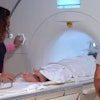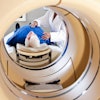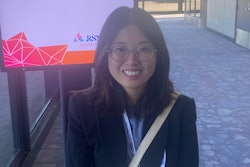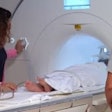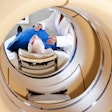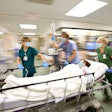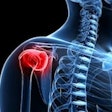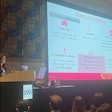Future healthcare success will rely heavily on giving priority to key technologies like point-of-care ultrasound, 3D printing of anatomical organs, and artificial intelligence, RSNA 2023 attendees are set to find out during Tuesday's keenly anticipated international session on Singapore.
Point-of-care ultrasound (POCUS) has been piloted by community health teams at Tan Tock Seng Hospital (TTSH) since 2021, with positive feedback, and it can influence patient management in more than 90% of cases when combined with clinical findings, Cher Heng Tan, MD, immediate past president of the Singapore Radiological Society, told AuntMinnieEurope.com ahead of the Chicago congress.
POCUS is particularly useful for assessing the cardiovascular system and lungs, and indications include fluid status, urinary retention, pneumonia, and deep vein thrombosis, according to Tan, who is a senior consultant at TTSH and assistant dean at Lee Kong Chian School of Medicine.
POCUS allows for real-time evaluation and administration of treatment, without reliance on facility-based scanning, i.e. radiology departments, and avoidance of unnecessary tertiary care referral is a major benefit, he added.
 The clinical implementation of point-of-care ultrasound is making steady progress. Courtesy of Dr. Joyce Yap, community geriatrician and lead for POCUS in Community (PIC).
The clinical implementation of point-of-care ultrasound is making steady progress. Courtesy of Dr. Joyce Yap, community geriatrician and lead for POCUS in Community (PIC).
The technology's value is limited by the expertise of the operator and poor conditions for diagnostic-quality ultrasound in the home and inpatient settings, and in primary care settings, there is a steep learning curve for staff, and accreditation and maintenance of skills are both essential, Tan pointed out.
There is considerable interest from emergency physicians and critical-care physicians, but coordinated training schemes are lacking, and such frameworks will need to encompass undergraduate and postgraduate training of a wide range of health professionals, both doctors and allied health professionals. Radiologists must engage with other care providers to find out where the gaps are and achieve more harmonization, he said.
Implementation of AI
The COVID-19 pandemic has been a major catalyst for AI adoption in Singapore. AI in healthcare is now a national priority, and AIM.SG is a national platform for imaging AI, Tan explained.
"Development and implementation are underway, but they require buy-in from institutional stakeholders," he said. "Proof-of-value remains the greatest hurdle for sustained implementation."
 Singapore has emphasized 3D printing of anatomical models. Courtesy of Dr Michael Yam, lead for 3D printing centre in Tan Tock Seng Hospital (TTSH).
Singapore has emphasized 3D printing of anatomical models. Courtesy of Dr Michael Yam, lead for 3D printing centre in Tan Tock Seng Hospital (TTSH).
Another important area is 3D printing. To support education, researchers at Nanyang Technological University, Singapore, and Imperial College London in the U.K. have created anatomical models based on medical images. Students have access to 3D-printed models with colors and texture resembling properties of the human body, and a mobile app that uses AI algorithms to display animated virtual 3D models is under consideration.
Imaging-based screening is also an emerging field. Over 85% of those presenting at an advanced stage would have benefited from a low-dose CT exam based on National Lung Screening Trial (NLST) criteria, and evidence shows non-smokers represent a third of patients diagnosed with lung cancer, according to Tan, who thinks diagnosis of sarcopenia and sarcopenic obesity using imaging biomarkers is evolving particularly fast.
Value-based radiology ("doing the thing right") and improving access to radiological expertise and services ("doing the right thing") are vital to success, he stated. The number of inappropriate requests for lumbar spine MRI exams has dropped by 50% due to local guidelines on Appropriateness Criteria for Use of Imaging Technology (ACUITy) formulated in 2019-2021, and chest x-ray guidelines have helped to eradicate pre-enrolment x-rays for asymptomatic young people entering local universities.
 Chest x-ray AI technology was introduced across Singapore during the pandemic. Courtesy of Dr. Cher Heng Tan.
Chest x-ray AI technology was introduced across Singapore during the pandemic. Courtesy of Dr. Cher Heng Tan.
"Radiology in Singapore is fully digitalized and well-positioned to capture opportunities in tech advancement, and this could alleviate issues of manpower shortage while improving precision care," he concluded. "Healthcare reforms require thoughtful balance between utilization and sustainability."
Workforce issues
Singapore is a young and very small country with challenges of a rapidly aging population, rising chronic disease load (e.g., cardiovascular disease, diabetes mellitus), and limited workforce, noted fellow RSNA speaker Dr. Lionel Cheng, senior radiology consultant and chief data and digital officer at Singapore General Hospital.
"Our challenges are not unique, but there are peculiarities about Singapore -- economically successful, tech-savvy population, stable political system, high value healthcare system -- which provide both opportunities and challenges," he told AuntMinnieEurope.com.
Radiology has undergone progressive subspecialization over the past three decades, and there has been a substantial rise in the number of diagnostic radiologists, averaging an annual growth rate of 9.9% since 2010. "Such growth is not sustainable, and we have to adopt other strategies to meet the challenges ahead."
Singapore must implement what he calls a more proactive "adaptive diversification" to revolutionize how it delivers radiology services and emphasis on big data and precision radiology. "There is a significant push into population health, and radiology will likewise have to go into new areas of "population radiology" such as enhanced screening and making more advanced imaging capabilities available in the community."
Cheng believes the main challenges are to continue to add value in the era of AI-powered physicians and patients; to amplify capabilities beyond traditional radiology roles (e.g., informatics, innovation, next-generation AI); and to advance new ground in less explored domains (e.g., population radiology, sustainable and green radiology).
Editor's note: "Singapore Presents: Radiology in the Lion City - The Pursuit of Excellence Within 284 Square Miles" takes place on Tuesday, 28 November at 9:30-10:30 a.m. CST.

